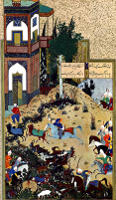
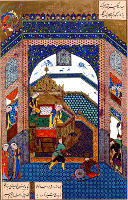
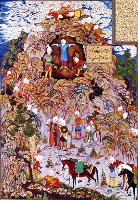
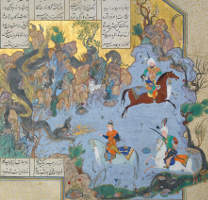
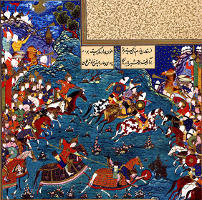
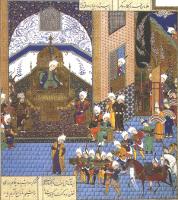
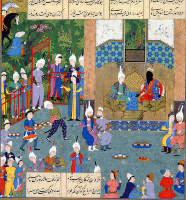
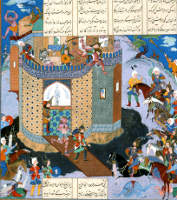
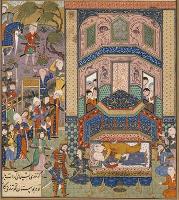
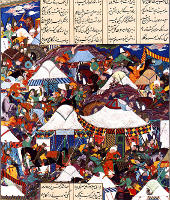
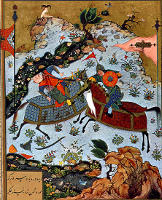
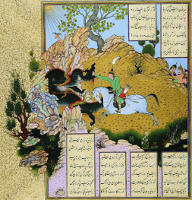
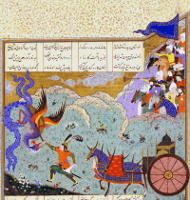
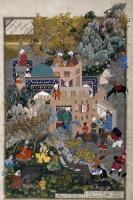
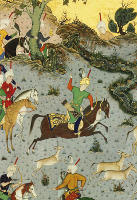
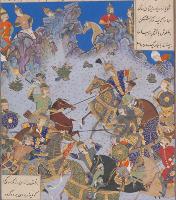
Illustrations from the Shahnama of Shah Tahmasp c. 1522-1540
The figures wear contemporary dress or dress of no latter than the date of the illustration.















Although the story is of earlier periods, the figures wear early 16th century Persian costume.
Composed in the tenth century by the poet Firdowsi, the Shah-nameh or Book of Kings is Iran's central literary work, a historical epic peopled with monarchs—some of inspiring goodness, others of unmatched wickedness—handsome paladins, beautiful maidens, malevolent witches, and treacherous demons. This manuscript of the Shah-nameh is the most sumptuous one ever produced. Containing scores of paintings where other sixteenth-century Shah-nameh manuscripts contain a dozen, the Houghton Shah-nameh (identified by the name of a previous owner, Arthur A. Houghton, Jr.) is thought to have been commissioned about 1522 by Shah Isma'il, the founder of the Safavid dynasty, as a present for his son, Prince Tahmasp. Court artists and craftsmen continued their work on the 759 folios for the better part of two decades; as a consequence, the book offers a fascinating mixture of artistic styles.
Text Links to images:
Zahhak Slays Birmayeh
f36v: Faridun Strikes Down Zahhak
f37: The Death of Zahhak. Aga Khan Museum AKM00155
f42: Faridun Tests his Sons
f102v: Qaran Fights Barman
Siyawus the son of Shah Kay Kawus (Kavus), enthroned in his palace at Balkh. Museum of Contemporary Arts, Tehran.
Kay Khusraw Welcomed by his Grandfather, Kay Kaus (Kavus), King of Iran. David Collection, Copenhagen, Denmark.
Kay Khusraw Captures the Demon-occupied Bahman Castle. David Collection, Copenhagen, Denmark.
f236r: The Iranians Mourn the Death of Farud and Jarira. The Metropolitan Museum of Art, New York, 1970.301.35.
f241r: The Besotted Iranian Camp is Attacked by Night. Metropolitan Museum of Art, New York, 1970.301.36
f341v: The First Joust of the Rooks (Rukhs) - Fariburz kills Gulbad
Gushtasp Kills a Dragon in Rum
Isfandiyar’s Fifth Ordeal; He Must Slay the Simurgh
The Story Of Haftvad And The Worm. Aga Khan Museum AKM 00164
f568r: Bahrain Qur Pins the Coupling Onagers. Metropolitan Museum of Art, New York, 1970.301.62
f707v: The war between the generals of Khusrau Parviz and Bahram Chubina. Metropolitan Museum of Art, New York 1970.301.72.
The Shahnameh manuscript made for Shah Tahmasp of Persia (1514-1576, reigned 1524-76) is a monumental achievement of artistic skill and patronage, and a work of breathtaking quality and exquisite beauty. Containing the greatest epic of Persian literature, profusely and magnificently illustrated by the greatest artists and illuminators of the royal atelier over a period of two decades, it is universally acknowledged as one of the supreme illustrated manuscripts of any period or culture and among the greatest works of art in the world. It is rightly regarded as the apogee of Persia art. The complete manuscript contained 258 ravishing illustrations, countless panels of exquisite illumination and some 30,000 couplets of poetry written in crisp, rhythmic nasta'liq calligraphy on 759 folios of burnished and gold-sprinkled paper. It was executed between about 1520 and 1540, at a time when the Persian arts of the book had reached their absolute zenith. The provenance of this copy of the Shahnameh is one of the most glittering of any manuscript. It was commissioned by one emperor, Shah Isma`il, completed by another Shah Tahmasp, gifted to a third, Sultan Selim II of the Ottoman Empire, and was later owned by one of the great bibliophilic families of the modern era, the Barons de Rothschild, whose Western manuscripts included such masterpieces as the Belles Heures of the Duc de Berry and the Hours of Catherine of Cleves.
the history of the manuscript
The Shahnameh or 'Book of Kings' is the Persian national epic, telling the history and legends of Persia from prehistoric times down to the end of the Sassanian dynasty in the seventh century AD. The author, Firdausi (circa 933-1020), assumed the task of writing the history of the Persian kings in verse in 976 after Dakiki, a poet friend who had started the work, was murdered, Firdausi devoted the remainder of his working life to composing the 30,000 couplets of the Shahnameh. The finished text was presented to Sultan Mahmud of Ghazna in 1010 AD, 1001 years ago this year. The text was henceforth to become a touchstone of Iranian royalty, the text which, above all others, was to be revered by kings as confirmation of their sovereignty and as a symbol of their dynastic legitimacy. From the 14th century onwards no cultured prince could ignore the obligation to commission his own illustrated version of the national epic.Shah Tahmasp's Shahnameh was probably commissioned by his father, Shah Isma'il (reigned 1502-1524), the first Safavid Shah of Iran. Shah Ismail was a dynamic, charismatic and powerful character who conquered the ruling Aq-Qoyunlu Turkman and Uzbek tribes, creating an empire which encompassed a vast area from the Caucasus in the north-west to the Oxus river in the east and the shores of the Arabian Sea in the south. The new empire took in the most important cultural cities of the region - Herat, Shiraz, Qazwin and Tabriz, where he made the new Safavid capital. By 1522, the probable date of commissioning of the manuscript, Shah Isma'il had completed his conquests and was becoming interested in the arts. Shah Tahmasp, as a boy only eight years of age, had just returned to his father's capital from Herat where he had been child governor. Shah Isma'il died in 1524, respected and revered by the entire court, and Shah Tahmasp continued his father's passion for the arts of the book and specifically the production of this monumental copy of the Shahnameh, devoting the royal atelier to its preparation and production for a period of nearly two decades. Probably no other Persian work of art, save architecture, has involved such enormous expense or taken so much artists' time.
Shah Isma'il's conquests of different regions and cultural centres had enabled him to gather artists of different training and experience. It was this composite nature of the atelier that led to a new and glorious hybrid style of Persian miniature painting, now known as the Tabriz style. In his extensive researches on this manuscript and early Safavid painting, Welch identified two main source styles: the Timurid tradition of Herat and the Turkman tradition of Shiraz and other centres. At Shah Tahmasp's atelier older masters worked side by side with younger artists, encouraging the development of individual artists' skills and enhancing the performance of the atelier as a whole. The manuscript shows the remarkable range of Persian miniature painting of the period, all of an extraordinarily high standard.
It is difficult to conceive of the artistic magnitude of the Shahnameh of Shah Tahmasp from our position in a different age and a different cultural tradition. There is no European equivalent of Shah Tahmasp's gathering of all the greatest artists of the era, along with the greatest scribes, illuminators, gilders, paper-makers, bookbinders and pigment-makers. But let us try to imagine a scenario in which the greatest patron of Renaissance Italy, perhaps Pope Julius II, gathered into one atelier the elite artists of the late 15th and early 16th century, both mature and young, along with their pupils, followers and workshops, and committed them to a single monumental project for a period of twenty years, during which time they worked on almost nothing else. The artistic goal of the Persian painter was book illustration. Western media such as fresco, panel or canvas did not feature in the Persian artistic tradition at this time. Therefore an Italian project of equivalent magnitude and significance would have to have been a national epic such as the Divine Comedy of Dante and to have included in one single, monumental and profusely illustrated volume the masterpieces of a host of Renaissance artists such as Leonardo, Bellini, Perugino, Michelangelo, Raphael, Giorgione, Titian, Corregio and more, and their pupils. Imagine such a manuscript, with 258 illustrations by artists of this calibre. It is an indigestible, almost surreal concept, and yet it is the inherent nature of this most glamorous of Persian manuscripts. Little surprise, therefore that Shah Tahmasp's Shahnameh enjoys such an illustrious reputation.
The manuscript has no colophon, and the only date is inscribed on one of the miniatures – AH 934 (AD 1527-8), but the illuminated dedication on folio 16 states definitely that the manuscript was made for the library of Shah Tahmasp. A second manuscript prepared for Shah Tahmasp is the Khamseh of Nizami, now in the British Library, London, (Or.2265; Welch 1979, 134-183, and published in most of the same reference works as the Shahnameh). The Khamseh is of similar dimensions to the Shahnameh and is usually regarded as its sister manuscript. In its present condition it contains fourteen contemporary illustrations, painted within a shorter period circa 1539-1543, thus representing the Tabriz style in its full maturity. With their contemporary inscriptions and attributions, the miniatures of the Khamseh provide a basis for comparison and attribution of the Shahnameh miniatures.
The first leading artist of the Shahnameh, and the one to whom much of the initial stylistic innovation is credited, was Sultan Muhammad. It appears that for a middle period the leadership was taken over by Mir Musavvir, and that towards the end it was Aqa Mirak, the artist of the present folio, who dominated the project. The atelier must have occupied at least fifteen painters, identified as separate hands by Welch. Usually an illustrated page involved the work of more than one artist, perhaps a result of the way in which the studio was organised for manuscript making. Certain pictures are attributed to the hand of one artist working alone, and among these are some of the finest miniatures of the manuscript (including the present example). For our knowledge of the artists of Shah Tahmasp's atelier we are fortunate that near-contemporary Persian commentators wrote about them and the nature of their work. Dust Muhammad, himself an artist who worked on the Shahnameh to a limited extent, was commissioned by Prince Bahram Mirza, brother of Shah Tahmasp, to assemble an album of fine and representative paintings and calligraphy. In his preface to the album he gives an informative account of the works of past and present painters. Those of Shah Tahmasp's atelier were of course contemporaries of his whom he would have worked with and known personally. The album, with Dust Muhammad's nineteen-page text, is in the Topkapi Saray Library, Istanbul (H.1721). For a translation of much of this text see Binyon, Wilkinson and Gray 1933, pp. 183-188. A later, more extensive treatise, is that written by Qadi Ahmad circa A.D.1606, of which several manuscript copies are extant (Minorsky 1959).
After about 1540 Shah Tahmasp's interest in the arts waned, he became increasingly religious and was weighed down with political concerns. The threat of invasion by the Turks from the west had been a recurrent problem, settled by treaty in 1555. When Sultan Suleyman the Magnificent died in Hungary in 1566, there were fears in Tabriz that the treaty might not be upheld by his successor Sultan Selim II (r. 1566-1574). In 1567 a Safavid embassy led by Shah Quli left for Turkey and met with the Sultan at Edirne in February of 1568. The pomp of the occasion was noted by the Hapsburg embassy, then also present at the Ottoman court. There were thirty-four camels bearing the most magnificent gifts from Shah Tahmasp to the new Sultan. Top of the list of gifts and thus rated the most valuable, were two manuscripts, one a copy of the Qur'an said to have been written by the Imam Ali himself, the other a Shahnameh. Records show that this was indeed Shah Tahmasp's great volume. The Shahnameh stayed with the Ottomans for over three centuries, preserved in almost miraculous condition. Unlike the miniatures of so many Persian manuscripts, the compositions of the Shahnameh illustrations were not generally used or echoed in subsequent manuscripts. This could be partly because of their size and complexity, but also because the volume left Persia so soon, later artists had little access to it.
The manuscript left Istanbul about the end of the nineteenth century and reached France. By 1903 it was in the collection of Baron Edmond de Rothschild who lent it for exhibition at the Musée des Arts Décoratifs in Paris, where the catalogue description gave no hint of its magnificence. It was probably MS.17 in the Rothschild Library. It passed to Maurice de Rothschild in 1934 and after his death in 1957 it was one of a number of outstanding Rothschild books offered for sale, principally in America.
It was acquired by the collector and bibliophile Arthur A. Houghton Jr., benefactor of the Houghton Library at Harvard University. The volume was disbound so that separate pages could be exhibited - at the Grolier Club, the Pierpont Morgan Library and elsewhere. In 1971, 76 folios with 78 of the 258 illustrations were transferred to the Metropolitan Museum of Art, New York. Further dispersals occurred over the next two decades, and in addition to those in the Metropolitan Museum of Art, there are leaves of Shah Tahmasp's Shahnameh in the Museum für Islamische Kunst, Berlin, The Freer/Sackler Gallery, Smithsonian Institution, Washington D.C., the Los Angeles County Museum of Art, the David Collection, Copenhagen, the Museum of Fine Arts, Richmond, V irginia, the Aga Khan Museum Collection, the Museum of Islamic Art, Doha, and the Museum of Contemporary Art, Tehran.
After the manuscript reached America Stuart Cary Welch embarked on a long and very thorough investigation and study of the manuscript, culminating in his great two-volume publication with Martin Bernard Dickson in 1981, The Houghton Shahnameh. It can safely be said that nobody has devoted as much time to the manuscript since circa 1540, while it goes without saying that the bulk of the information given here is derived from the published fruits of that study. The following works in the bibliography contain information on, or are devoted to Shah Tahmasp's Shahnameh: Welch 1972; Welch 1976; Welch 1979; Dickson and Welch 1981; Welch 1985; Soudavar 1992, Melikian-Chirvani 2007, Brend and Melville 2010.
Source: Sothebys